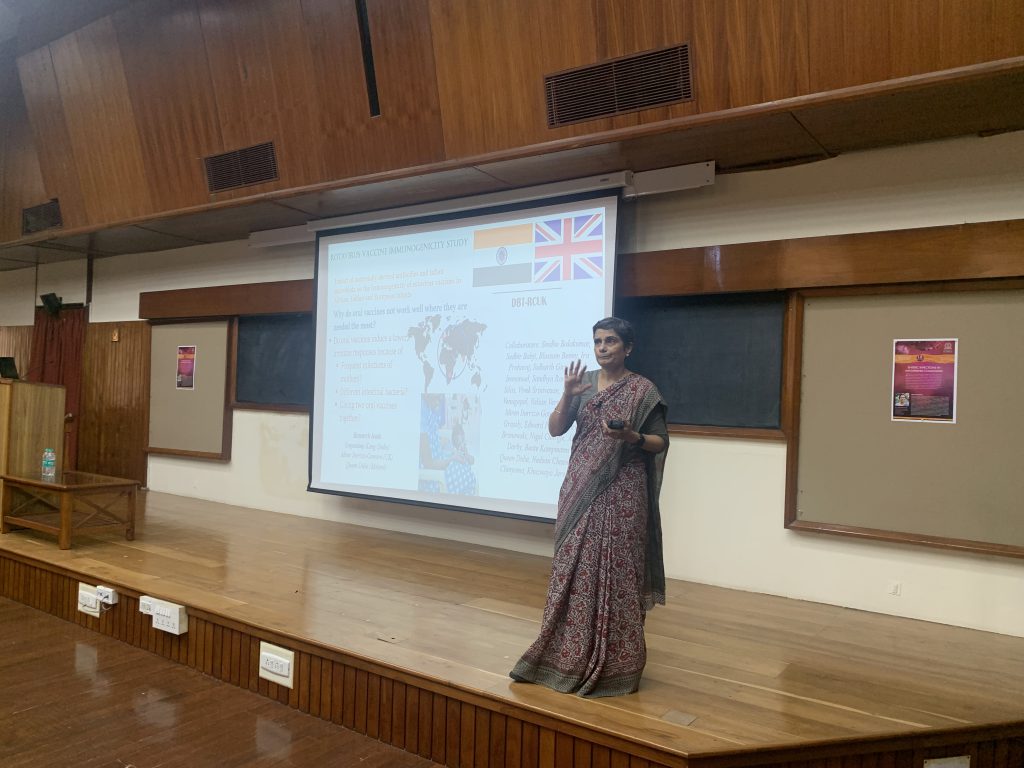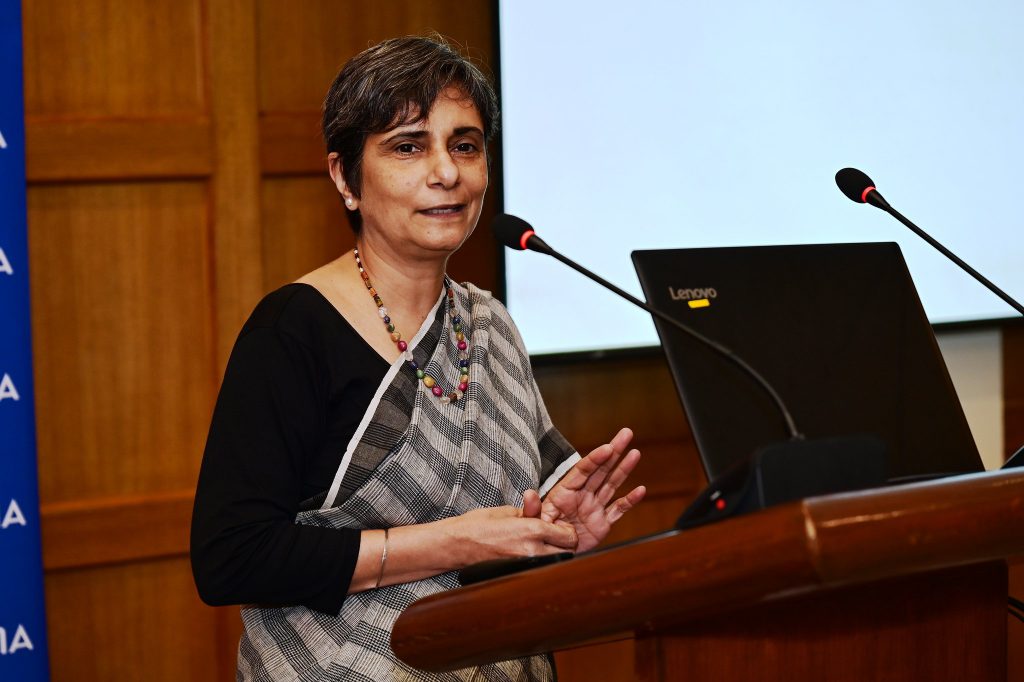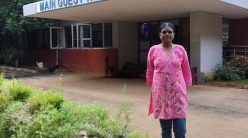Gagandeep Kang is an interdisciplinary researcher famed for her work on enteric infections. She was part of the teams responsible for the development of two Indian rotavirus vaccines, Rotavac and Rotasiil, and has worked extensively on viruses that cause different types of diarrheal diseases and on typhoid surveillance networks. She completed her MBBS in 1987, her MD in Microbiology in 1991 from Christian Medical College (CMC), Vellore, and her PhD in 1998. She carried out her postdoc at Baylor Medical College, Houston, USA, before returning to CMC.
Gagandeep is the recipient of the Infosys Prize in 2016 and the first Indian woman to be elected as a Fellow of the Royal Society of London. She is currently the Director-Enterics, Diagnostic, Genomics and Epidemiology, Global Health at the Bill and Melinda Gates Foundation. On 18 December 2023, she was at IISc to deliver the Institute Lecture on “Enteric infections in impoverished communities” at the Faculty Hall. Following the hugely popular talk, CONNECT sat down with her for a freewheeling chat about everything from pandemics and women in STEM to zombies.

What is your role in the Gates Foundation?
I’m the director of a team that is called EDGE – Enterics, Diagnostics, Genomics & Epidemiology. We also have modelling. The way the Foundation works is that we have a defined strategy for each area. And in that strategy, we will find and fund programmes that lead us toward our goals. One example I can give you is cholera. For instance, in India and Bangladesh, cholera is an endemic disease. We don’t use cholera vaccines in our country. It’s not recommended. Even if we wanted to use the vaccine, there is no supply because right now, Africa is having so many cholera outbreaks that whatever vaccine there is, it is going to Africa. One thing we are working on is to increase the supply of cholera vaccines in the world. We just gave a grant to an African company called Biovac in South Africa to try and get them to manufacture a cholera vaccine. We’re also working with an Indian vaccine company for the same. So, we find what the problem is, think about how to solve it and then implement that solution.
In the last couple of years, we’ve seen COVID-19 vaccines being developed quickly. Will this have any bearing on how we develop vaccines in the future?
I hope it does. Because we will develop vaccines faster in the future. Usually, if you do a vaccine trial, you will test the vaccine in 10,000-20,000 people. During COVID-19, each of those vaccines that came to the market was tested on 25,000-40,000 people. The trials were bigger. Usually, when you do vaccine development, you do a preclinical trial, stop and review the data. [For example], do phase one [trials], stop, and review the data. Then do phase two [trials], stop and review the data. [During COVID-19 vaccine development], phases one and two were almost combined with a faster reviewing of the data as soon as they came in. All the testing was done, but those trials were done in overlapped phases instead of following stop, start, stop, start. The biggest learning was that we can make vaccines faster if everyone works together.
Do you see the potential for another pandemic?
Yes! But is it going to happen tomorrow or in 10 years? I cannot tell you.
“The biggest learning was that we can make vaccines faster if everyone works together”
Let’s talk about communicable diseases.
I think the biggest communicable disease battle that we have right now is TB (Tuberculosis).
Why is it so difficult to find a vaccine for TB?
Usually, vaccines against viruses are easy to make; bacterial vaccines are harder, and parasite vaccines are even harder. Even in bacterial vaccines, extracellular bacteria are easier, and intracellular bacteria are harder. TB is caused by an intracellular bacterium that can infect cells responsible for immunity. So, it becomes even harder to make a vaccine for TB.
We are always concerned about potential diseases like Ebola.
It is a viral haemorrhagic fever. But it is a viral haemorrhagic fever that people have survived.
But the high mortality rate?
It is serious and can be fatal, but also look at mortality rate when people have gotten care at a good facility versus when they have not.
Is Nipah worse than Ebola? We have frequent outbreaks in India now.
Nipah is much worse, causing more deaths in the infected than Ebola. But Nipah does not spread as much as Ebola does. Also with Nipah, there is a certain amount of variability because in the outbreaks that we have had, some people spread the virus a lot and some people hardly spread it. What determines who spreads to 15 other people versus somebody who spreads to one other person? We do not know this. It may be a difference in strains. It may be a difference in the host in terms of how the virus is replicating. We have this super spreader phenomenon. People who shed a lot of viruses and infect many people. So, it may be a host phenomenon rather than a strain difference, but we do not know.

Changing lanes a bit, you have done so much work on viruses that cause diarrheal diseases. Historically, diarrhoea was a killer. Now when you see how the disease is being managed, what do you think of that change?
It is fantastic! And it is down to better management protocol. Oral rehydration solution (ORS) is the biggest game changer that ever happened for most diarrheal diseases. The gut is an organ that replicates itself very fast. If you look at the lining of the gut, it takes you about one week to replace the whole lining.
ORS is a solution made based on understanding the physiology of the gut and then addressing the issues of what is needed to have better absorption and less fluid loss. That is why it is a balanced salt and sugar combination.
But while ORS is fantastic, the problem for many diarrheal diseases is that there is both vomiting and diarrhoea. So, when you vomit, then you cannot use ORS. So, even though we have ORS as the main treatment form, we still need IV rehydration and prevention strategies for diarrhoea where possible. The problem with doing IV rehydration is if a child has diarrhoea and vomiting, you want to start an IV. But starting an IV on a dehydrated child is very difficult. It can be done in a high-end facility but most of the children that get dehydrated will not come to a high-end facility and might die. That is why we want to have both prevention and treatment.
So, what is the biggest challenge and how to tackle it?
I think the biggest challenge for diarrheal disease is the same as for all public health. It is access to diagnostics, treatment, and preventive strategies. It is a difference in distribution, right? Rich people can get everything they want. Poor people cannot. So, it then becomes the responsibility of public health systems to be able to provide poor people with what they need. Just because you are poor, if you are not able to access medication or good treatment, it is unfair. We all have a right to health. If we have that right, why should your socioeconomic status determine how much access you have to healthcare?
“Why should your socioeconomic status determine how much access you have to healthcare?”
How would you navigate that?
You look at the countries that provide universal health care, they are so far ahead of us in terms of development. Why should we not have that? All expenses are a question of prioritisation. What should you spend on, so that you have a healthy society tomorrow? You tell me.
Healthcare? Making food cheaper and safer?
You want healthcare, you want nutrition. What else do you want to have in a healthy developed society tomorrow?
Playgrounds?
Very good. That’s part of healthcare, and what else?
Mental health, I guess, I’m not really sure.
Absolutely. You already know what should be prioritised for a healthy society, don’t you?
Switching again. Since the time that you started, do you see an increase in the representation of women in science?
One of the things that people often ask about is why aren’t there more women in science. And for India, I will turn that question around and say, why aren’t there more women working? In terms of formal employment, what is the proportion of working women in India? I don’t think we addressed that enough. Our socio-cultural context is that you get an education, at least that much has changed for some parts of society. But then it isn’t accepted that you work in a tough, demanding job.
There is a belief that the high school level is where you must really encourage kids to follow a path. Another suggestion is to keep women who are working in science employed. I want to know your opinion.
If I think about it from the point of view of running a lab: If I have a PhD scholar that needs to take six months off for maternity leave, I must have the resources to cover that. So, while I do not think that this is how society should function, I can imagine that if you are a young PI (Principal Investigator) who only has three PhD students, the last thing you want is one of those PhD students taking off for six months. But what I have discovered, working mostly in a lab that had women, is that if you provide those resources to women when they need it – the flexibility, the time off – they will outperform all the men when they come back and work. It is just the way things are. People understand they have a responsibility and fulfil all their commitments. All they need is a little bit of flexibility. And if a system can allow for that flexibility, I think then there is no problem in judging women professionals and men professionals with the same yardstick.
“If you provide those resources to women when they need it – the flexibility, the time off – they will outperform all the men when they come back”
I know someone who was giving job interviews. She was around 26 and planning to get married at the time. They were concerned that she might need maternity leave soon.
This happens all the time. How many formal jobs do we have in this country? 90% of our jobs, even the so-called salaried jobs, are for daily wage workers and contract workers. Less than 10% of our jobs are proper salaried jobs. If there is a premium on those kinds of positions, people are going to be able to get away with unfair work practices. You should not have a bias against women because they might get married or pregnant or need time off for childcare. But it is going to take us some time to mature as a society and to realise that. We have to expand the job market. We must improve the working conditions for women. It is not necessary that one follows the other. We must focus on both together.

(Photo courtesy: Gagandeep Kang)
Taking another detour, your childhood…
Perfectly normal childhood (laughs).
But I read 10 schools in 10 years…
Everyone wants the story, right? Lots of kids in the army change schools. Any central services official’s children will change a lot of schools. I, too, did that. It was great.
Did you want to be an air hostess as a child?
Yes. My uncle had a set of comic books which were called Classics Illustrated. They were very old. Every time I went to Ludhiana to my grandparents’, there was a tin box with all these comics, and I would read them. At the end of the comic, there used to be two half pages about future careers. I was fascinated with the idea of being an air hostess. There was no chance of me being a pilot at that time, that came later. But travelling around the world, seeing new places and things like that … I was devastated when I discovered that you had to have a 6-6 vision to become an air hostess. At 14, I got glasses. If you have glasses, you can’t be an air hostess. It was the end of my life. No ambition (laughs).
So, how did the turn happen?
I read a lot. I loved biology. Physics, not so much. Chemistry and maths were okay. I also loved history, geography, and English. I liked studying everything, but then when it was a question of choosing, I thought history and geography, you can read anytime. But the other subjects require more study, so that is what I chose to do.
From there to now, when you are called the “Godmother of vaccines” in India, how does that feel?
People come up with labels. I like the work I do. I thoroughly enjoy it. I love working with young people and seeing them get excited about doing new things. That is the best part.
I wanted to end on a stupid question. I was reading about certain parasites that get into animals and then make them do things. So, is there a possibility of zombies?
Zombie ants do exist…
No, no, the Resident Evil or Walking Dead-type zombies we see on TV.
Hmmm… One way of thinking about it is that a lot of brain infections cause you to change behaviour. If you think about viral encephalitis, for example, one of the key [symptoms] is that people’s behaviour changes. Sometimes clinicians pick up infections because a person is behaving oddly. So yeah, it’s perfectly feasible to think about significant changes in behaviour caused by infections. Will they end up eating people? I do not know.




